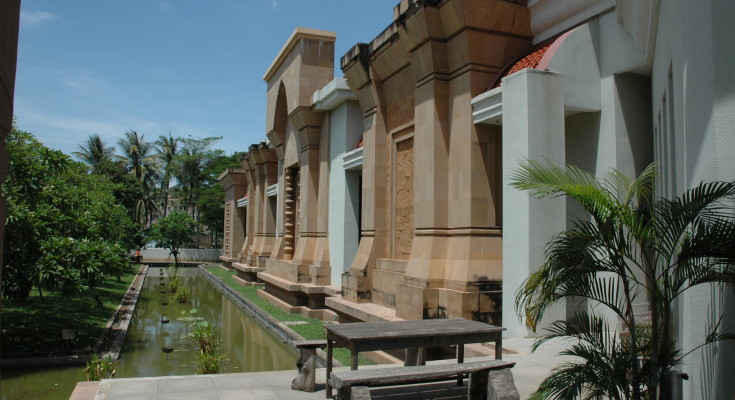This year we had the privilege of participating in a press visit to Cambodia. The country is benefiting from two decades of relative stability, having endured civil war and the murderous rule of the Khmer Rouge. Tourism is an important economic pillar and Cambodia welcomes foreigners with open arms. But the country is also aware of negative aspects of mass tourism. Thus seeking for a balance between protecting its remarkable cultural heritage (like Angkor Wat) and earning American dollars to build up the country. Below more information on the country, its people and history. 
Women on Silk Island, near Phnom Penh
At the market in Siem Reap
Some information on Cambodia
Cambodia is benefiting from two decades of relative stability, having endured civil war and the murderous rule of the Khmer Rouge. As it attempts to end its dependence on foreign aid, the country’s economic potential and natural resources are drawing foreign investment – especially from China and neighbouring Vietnam. Garment-making is the biggest industry, employing around half a million people and accounting for 80% of exports. Tourism is expanding, and Cambodia hopes to tap into offshore oil and gas reserves.
However, corruption is deep-rooted and Cambodia is still one of the world’s poorest countries, with around one third of people living on less than one dollar per day.Most of the workforce is employed in subsistence farming. The Mekong River provides fertile, irrigated fields for rice production. The government in 2012 approved the controversial Sesan 2 dam project to boost hydroelectric power on the river.
Of late, land concessions and forced evictions have sparked social unrest. Many thousands of people have been displaced as the government has granted land to companies who are keen to exploit resources such as rubber, sugar and minerals. Confrontations between locals and the authorities are commonplace.
Meanwhile, years of widespread illegal logging have led to a rapid decline in Cambodia’s forest cover. International watchdog Global Witness says top officials are involved in the trade. The powerful Khmer Empire once included parts of present-day Thailand, Laos and Vietnam. The imposing temple complex at Angkor, built between the ninth and 13th centuries by Khmer kings, is a UN heritage site and a big draw for visitors.
The fate of Cambodia shocked the world when the radical communist Khmer Rouge under their leader Pol Pot seized power in 1975 after years of guerrilla warfare. In pursuit of a rural utopia, the Khmer Rouge abolished money and private property and ordered city dwellers into the countryside to cultivate the fields.
Up to two million people died, many from exhaustion or starvation, while others were tortured and executed, until an Vietnamese-led invasion ended Khmer Rouge rule in 1979. A UN-backed tribunal aims to bring those responsible for the “killing fields” to justice. Only three senior Khmer Rouge figures have been convicted so far.
Unexploded landmines from Cambodia’s civil war, in which Vietnamese fighters and US forces were also embroiled, continue to kill and maim civilians, despite an ongoing de-mining drive. More recently, tensions along a disputed stretch of the Cambodian-Thai border have stoked skirmishes between the two countries’ militaries. (source: bbc.com)
Some information on the country
Cambodia is benefiting from two decades of relative stability, having endured civil war and the murderous rule of the Khmer Rouge. As it attempts to end its dependence on foreign aid, the country’s economic potential and natural resources are drawing foreign investment – especially from China and neighbouring Vietnam.
Garment-making is the biggest industry, employing around half a million people and accounting for 80% of exports. Tourism is expanding, and Cambodia hopes to tap into offshore oil and gas reserves.
However, corruption is deep-rooted and Cambodia is still one of the world’s poorest countries, with around one third of people living on less than one dollar per day.
Most of the workforce is employed in subsistence farming. The Mekong River provides fertile, irrigated fields for rice production. The government in 2012 approved the controversial Sesan 2 dam project to boost hydroelectric power on the river.
Of late, land concessions and forced evictions have sparked social unrest. Many thousands of people have been displaced as the government has granted land to companies who are keen to exploit resources such as rubber, sugar and minerals. Confrontations between locals and the authorities are commonplace.
Meanwhile, years of widespread illegal logging have led to a rapid decline in Cambodia’s forest cover. International watchdog Global Witness says top officials are involved in the trade.
The powerful Khmer Empire once included parts of present-day Thailand, Laos and Vietnam. The imposing temple complex at Angkor, built between the ninth and 13th centuries by Khmer kings, is a UN heritage site and a big draw for visitors.
Legacy of conflict
The fate of Cambodia shocked the world when the radical communist Khmer Rouge under their leader Pol Pot seized power in 1975 after years of guerrilla warfare.
In pursuit of a rural utopia, the Khmer Rouge abolished money and private property and ordered city dwellers into the countryside to cultivate the fields.
Up to two million people died, many from exhaustion or starvation, while others were tortured and executed, until an Vietnamese-led invasion ended Khmer Rouge rule in 1979.
A UN-backed tribunal aims to bring those responsible for the “killing fields” to justice. Only three senior Khmer Rouge figures have been convicted so far.
Unexploded landmines from Cambodia’s civil war, in which Vietnamese fighters and US forces were also embroiled, continue to kill and maim civilians, despite an ongoing de-mining drive.
More recently, tensions along a disputed stretch of the Cambodian-Thai border have stoked skirmishes between the two countries’ militaries.
(source: bbc.com)




































